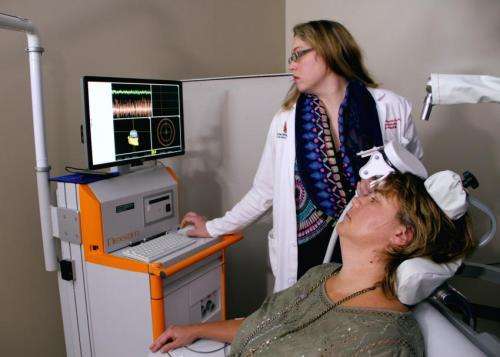Device controls brain activity to maximize therapy

Researchers at The Ohio State University Wexner Medical Center are trying to help patients who have suffered a stroke to improve arm movement by stimulating the brain using a device called a Transcranial Magnetic Stimulator (TMS). By using TMS to reduce brain activity on the side that was not injured by the stroke, the injured side may have a better chance of recovering.
The idea is that when one side of the brain is damaged by a stroke, the healthy side tends to generate much more activity to compensate, but that may actually prevent the injured side from recovering, said principal investigator Dr. Marcie Bockbrader, assistant professor of Physical Medicine and Rehabilitation at Ohio State.
Ohio State is one of 12 top rehabilitation sites nationwide participating in the multicenter clinical trial that will enroll up to 200 patients during the next two years. Nexstim has launched the double-blinded, randomized, and sham-controlled trial to determine the therapeutic effects of navigated rTMS (repetitive transcranial magnetic stimulation) for stroke rehabilitation. This stroke therapy combines occupational therapy with navigated repetitive transcranial magnetic stimulation (n-rTMS).
"NexStim is a way to specifically stimulate a brain area of interest, said Bockbrader. "In our study, we are stimulating the motor areas that are sometimes injured in a stroke. This device targets the overactive side, quieting it down enough, so that through therapies, the injured side can learn to express itself again."
To qualify for the study, participants must have had a stroke at least three months ago, but no more than 12 months ago and continue to have weakness in the arm and hand on one side. All participants also receive six weeks of hand and arm therapy free of charge. An occupational therapist focuses on improving movement, flexibility, strength and use of the weak arm and hand. The study lasts for up to eight months and will involve up to 29 visits.
"In this particular study, we are looking at people who are 3-12 months after stroke who haven't recovered all the way and are trying to use this technology to boost their recovery process to restore the brain balance," Bockbrader said.
Researchers are using stereotactic MRI-guided repetitive transcranial magnetic stimulation (rTMS) to non-invasively modulate precise areas of the motor cortex. The system's targeting tool allows the therapist to accurately locate the patient's exact stimulation target using technology similar to mapping the globe with a GPS. The n-rTMS is used to stimulate the patient´s non-injured brain hemisphere at a low frequency, said co-investigator Stephen Page, associate professor of Health and Rehabilitation Sciences at Ohio State.
This results in down-regulation of the excitability of the healthy side and restoration of the balance between the lesioned and healthy sides, allowing the lesioned side to regain function. Adding navigation to TMS is the key to finding the exact location and orientation of the motor area that should be inhibited by stimulation. The stimulation is then accurately repeated in every session, assuring the dose is applied to the correct place, said co-investigator Lise Worthen-Chaudhari, assistant professor of Physical Medicine and Rehabilitation at Ohio State.
"What we're doing is allowing the brain to be ready and more receptive for therapies," said Bockbrader. "It's not a technology that's limited to just motor recovery after stroke, it seems to be something that has a potential to affect many of the brain circuits that are injured in stroke."















